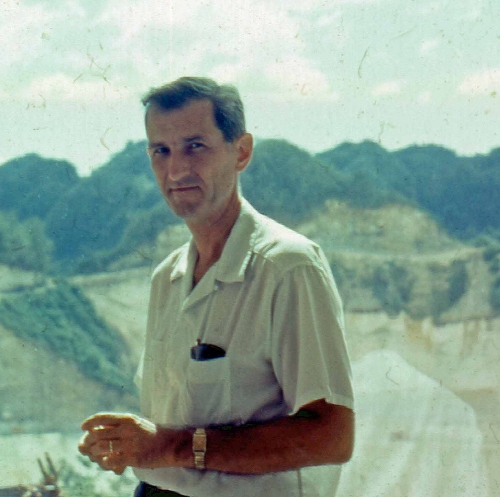 Bill Gordon at Arecibo, ca. 1961 (photo courtesy of Marshall H. Cohen)
Bill Gordon at Arecibo, ca. 1961 (photo courtesy of Marshall H. Cohen)
William E. Gordon
Contributed by Marshall H. Cohen
William E. (Bill) Gordon was born in Patterson, NJ on 8 January 1918, and died
on 16 February 2010. He studied mathematics at Montclair State Teachers College and
received a BA in 1939 and an MS in 1942. During the war, and for a few
years after, he studied tropospheric radio wave propagation, including
long-range propagation via ducting, and via scattering on turbulence. He
worked with Henry Booker at Cornell University, receiving a PhD degree
in Electrical Engineering in 1953. In 1950 they published an important
paper on turbulence in the troposphere and long-range propagation;
this formed the basis for understanding "forward scatter" propagation
that has had many important applications. Gordon stayed at Cornell and
worked on troposphere propagation experiments with students, and until
the mid-50s supervised the solar radio astronomy program at Cornell.
In 1958-59 Gordon conceived and designed the 1000-foot Arecibo radar,
not for radio astronomy but to measure the properties of the topside
ionosphere. It was dedicated in 1963. The exceptionally large size
allowed for many advanced experiments in ionospheric physics, planetary
radar, and radio astronomy. It has made many detailed solar system
radar measurements, including the rotation rates of Venus and Mercury
and imaging asteroids and the moons of the outer planets. It was used to
find the two known orbiting pulsar systems, which are important
for testing theories of gravitational radiation.
Bill did research in ionospheric physics at Arecibo for about 30
years, including the many years he spent at Rice University as a
senior administrator: Dean, Provost, and Vice-President. He worked
extensively with graduate students from both Cornell and Rice. Much
of his work involved heating experiments, where a powerful HF wave
(5-10 MHz) would illuminate the ionosphere and heat it near the local
plasma frequency. The Arecibo radar would then study the heated volume,
to measure density and temperature changes, motions, and the formation
and decay of irregularities. Gordon and his groups worked closely with
the plasma physics community in these efforts.
Bill received many honors for his work. He was a member of the National Academy of Sciences and
the National Academy of Engineering, and a Foreign Associate of the Engineering Academy of Japan.
He received the Balth van der Pol Gold Medal from URSI, the Medal of the
American Meteorological Society, the Arctowski Gold Medal of the National Academy of Sciences,
a medal from the USSR Academy of Sciences, and the Centennial Medal of
the University of Sofia.
Modified on Tuesday, 09-Aug-2011 11:26:02 EDT by Ellen Bouton, Archivist (Questions or feedback)
|
![[IAU logo]](iau_wb_thumb.jpg)
![[URSI logo]](URSI-logo-thumb.jpg)
![[Karl Jansky at his antenna]](jansky_photo_02_thumb.jpg)
![[Reber's Wheaton antenna]](Reber_Telescope_Wheaton_thumb.jpg)
![[Dover Heights]](Dover_Heights_02_thumb.jpg)
![[4C telescope]](GB61-195_4C_telescope_thumb.jpg)
![[Ewen and horn antenna]](ewen_horn1s.jpg)
![[Dwingeloo, 1956]](Dwingeloo-1956-thumb.jpg)
![[Jocelyn Bell Burnell and Cambridge antenna used in pulsar discovery]](burnell2_thumb.jpg)
![[Lovell Telescope at Jodrell Bank]](site_1594_0001-500-334-20180316163019-thumb150.jpg)
![[Wilson, Penzias, and Bell Labs horn antenna]](wilson-penzias-horn_thumb.jpg)
![[6-m Millimeter Radio Telescope in Mitaka, Japan]](6m-thumb.jpg)

